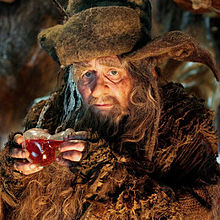 Designer Ann Maskrey had the wonderful job of creating the costumes for all of the characters in The Hobbit. She’s been talking to the LA Times Hero Complex about her work on film.
Designer Ann Maskrey had the wonderful job of creating the costumes for all of the characters in The Hobbit. She’s been talking to the LA Times Hero Complex about her work on film.
Ann had to create an individual look for each dwarf. She says,
It was quite a challenge really, simply because there are 13 of them, and Peter Jackson wanted them to have such a distinct, separate look from each other. He really was very keen on them having a different silhouette even before we started talking about the different colors they would all have. And then beyond that, he wanted distinct characteristics, and also distinct hierarchy, because some of the dwarves are more noble than others. So I had to emphasize all of that in just the choice of fabrics and the level of decoration, and by the time you get to dwarf No. 7 of 13, you’re thinking, “How are we going to make the next one look different?” It’s difficult, but great fun, actually too. I did learn an awful lot as I went along. Even though I’ve done a lot of other movies in the past, I’ve not really done anything quite like that with so many key principals really up front the whole time, and had to design it to the level of detail that we’ve done.
And how much time did it take to design each costume?
I didn’t have very much prep time. I was only asked to be the costume designer, I think, four months before we started shooting, which for a film this size and scale — now three films — that’s very, very little time to do it in. … You have to bear in mind that Peter’s done “Lord of the Rings”; they’ve got a back history. Things have got to blend with that. I have to get producer and director approval before we can start, so sometimes that process takes a long time, because they’ve all got to agree. … Sometimes you’re given pages three days before a costume would be in front of the camera, and it would be something that you didn’t even realize was in the script before. That happens on nearly every movie — you suddenly have to do another outfit, and you’ve got like a day or two days’ notice. You get used to it. … I love designing. I’m perfectly happy if someone gives me a challenge, and it certainly was. There’s a lot of work. The dwarves, particularly, once you’ve got 13 dwarves approved in that first costume, and then done the camera test, and everyone’s happy, you’ve then got to do the repeats for the stunt people, and the repeats for the small-scale dwarves, and they’ve all got to look identical, and it’s just a huge amount of work for the workroom to cope with, and at that point, I have to think about the next thing and what comes after that.
Ann is most proud of the costumes for Galadriel and Radagast. Talking of Radagast she says,
The costume used every part of the workshop to the fullest. We had embroidery done, we had fabrics made, we had fabrics dyed, the break-down team worked on it, the milliner did a great hat, the boys that made all the footwear did really nice shoes for him. To me, that was one of the most successful ones. And he’s a new character.
I very much wanted him to be very textured, like some bit of gnarled old tree bark. There was a little bit in “The Hobbit” – in the script and a hint of it in the books — where you just feel that he suddenly appeared from behind a tree. So I wanted him to disappear into the forest and look like he was part of it, very organic looking. Peter Jackson himself wanted a real lopsided quality to him, but that really came about from having like one long sleeve, one that was torn off, odd shoes, an uneven hem, and then his waistcoat is buttoned up all irregularly. But I had such fun really doing the embroidery designs and picking the fabric, because it’s not all brown; there’s yellows and blues in there. There’s a couple of really good textile girls that I worked with, [and they injected] little threads into the felt [of his hat], and it looks like moss is growing in the hat. I suggested something for the collar on the top coat, where you sewed lots of strips of felt side by side, and then butted them up to each other irregularly, and that looks like tree bark. And we had a lot of fun creating textured fabrics. I’m really fond of layering one fabric over another and then sort of peeling some of it away. I just think it’s particularly successful really. I have to still say it’s probably my favorite. It’s all from the forest.
Attention to detail was vital,
You have to. Because the thing is, even if that costume that you spent hours on is only seen on camera for a few seconds, and it flits by, and the lighting’s dark, you know that on a film the scale of “The Hobbit,” at some point there’s going to be a big still photo of it, and at some point it’ll be in some exhibition, and you want to be able to go, “Look at that embroidery. Isn’t it lovely?” Sometimes you don’t see the detail in the movies, but because it’s 3-D and 48 frames per second, you do feel like you’re falling into the picture. You’re going to see a lot of it. So you couldn’t just slap it together.


